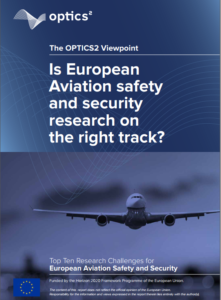OPTICS2 assesses the progress of European Aviation Safety and Security Research and Innovation (R&I) and provides recommendations to help steer EU Aviation R&I in case certain research needs are not being met, or corrections are required (i.e. when new disruptive technologies, or global events such as COVID-19).
In our article “Top Ten Research Challenges for European Aviation Safety and Security”, the main issues EU aviation safety and security research is focusing on are outlined and discussed.
Here is an extract of the top 3 Safety and Security R&I.
Safety Research Priorities:
3° The future aviation workforce will be different from today, with more automation, more distributed teams, and new roles and ways of working .To select and train this workforce we need to understand how work is really done today, across all aviation sectors […]
2° Research is needed on new ways of organizing the air transport system, together with new ways of communication, interaction and joint decision-making, to ensure the system is more resilient against emerging and sustained hazards, such as the COVID19 pandemic.
1° Ensure the safety of the future aviation ‘skyscape’ addressing the full future complexity of current and novel manned and unmanned vehicles […] Safety risk modelling will need to raise its game to determine how these aerial systems can share the airspace safely, by using multi-actor risk modelling to inform the development of an all-inclusive CONOPS.
Security Research Priorities:
3° Research is required to develop an Aviation-Wide Security Culture, and provide associated validated, mature training material.
2° A more strategic and collaborative capability-driven process for security is required, backed by regulation and policy to provide a secure and resilient transport system through improved integration of systems and procedures across the four transport modes
1° A more strategic and collaborative approach for biological threats to an international air transport system needs to be researched and supported by policy/regulation, as required by the advent of the COVID-19 pandemic
Download the report to read more!

